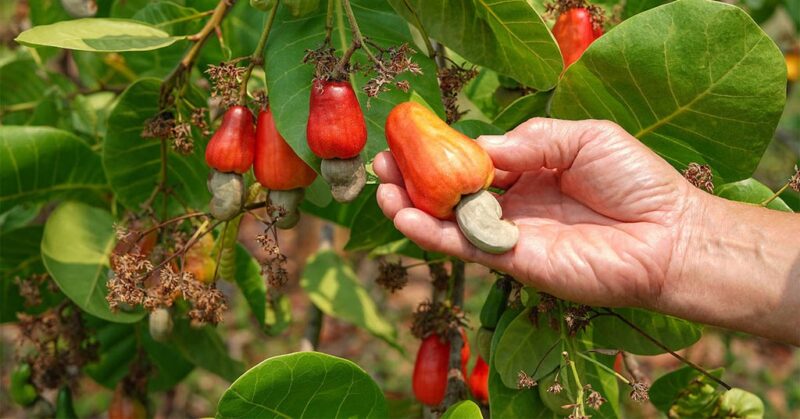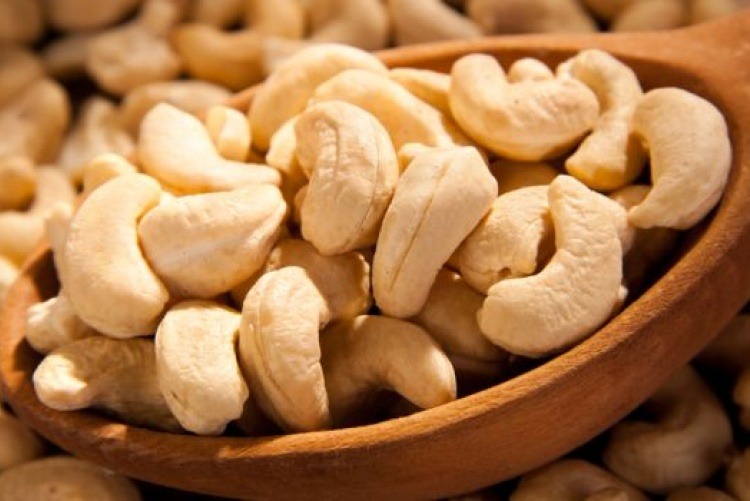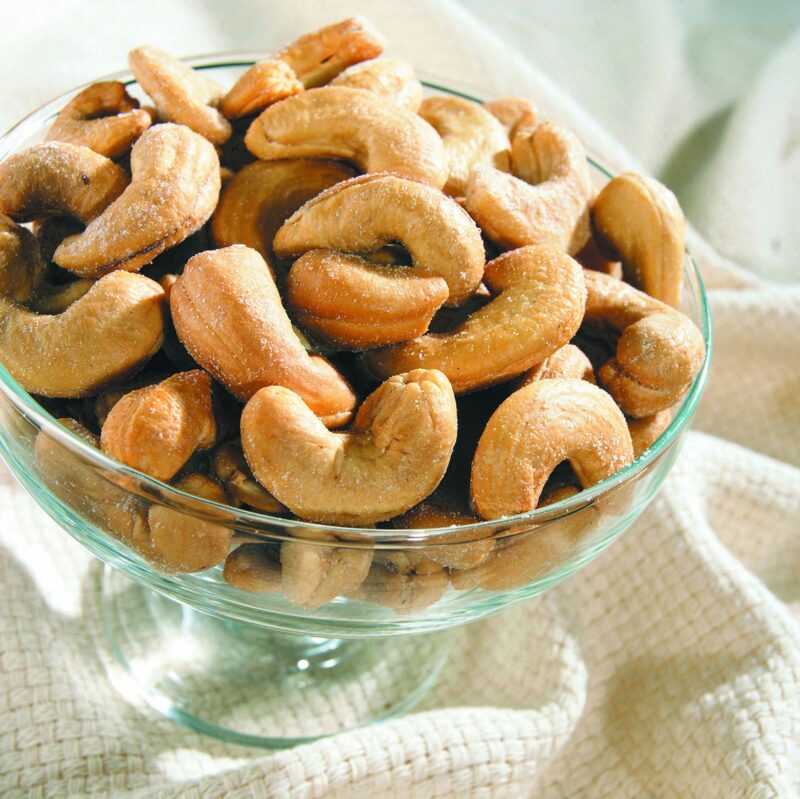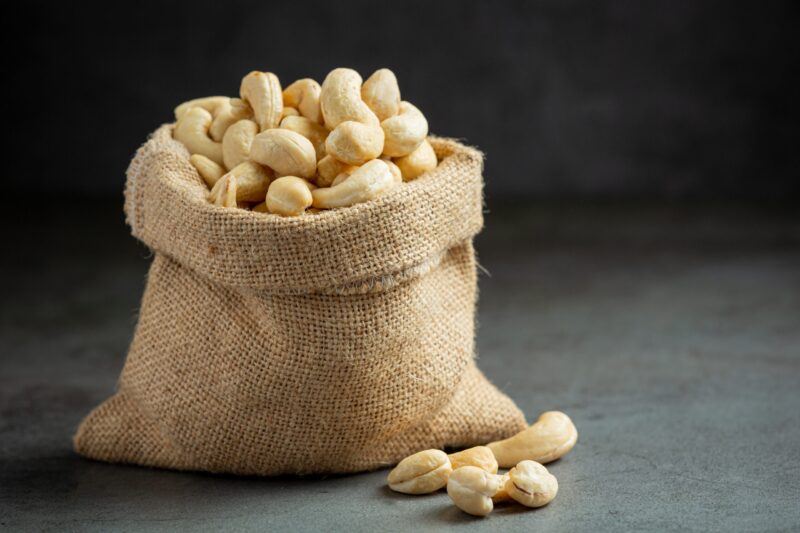Cashew nuts don’t grow like other nuts. They hide in plain sight, attached to bright, bell-shaped fruits. Their journey spans continents and climates, moving through forests, farms, and factories before they reach your snack bowl. If you’ve ever cracked open a packet of cashews and wondered where they really come from, now’s the time to follow the path.
Key Highlights
- Cashew trees grow mainly in tropical regions, especially in Asia and Africa.
- The nut develops outside the fruit, protected by a toxic shell.
- Processing cashews requires labor-intensive steps for safety and taste.
- Top producers include Vietnam, India, Nigeria, and Brazil.
- Malaysia is a growing market for quality cashew nut distribution.
- Demand for roasted and premium-grade kernels continues to rise.
The Origin of the Cashew Tree

Cashew trees thrive in hot, humid regions with well-drained soil. The tree originated in Brazil, where indigenous communities used both the nut and fruit. Portuguese explorers brought cashew seeds to other tropical parts of the world in the 1500s.
Today, countries like Vietnam, India, and Nigeria dominate production. The tree takes about three years to start producing and can yield up to 50kg of nuts annually under the right conditions.
Cashew apples, the colorful fruits attached to the nut, are often discarded during commercial processing. Locals in producing countries may use them for juice, jams, or even liquor.
What Makes Cashews Unique
Cashews don’t grow inside the fruit like almonds or walnuts. Instead, the nut appears in a shell hanging beneath the cashew apple. That shell is toxic and must be removed carefully.
Processing involves several steps:
- Harvesting – Farmers collect ripe apples and separate the attached nuts.
- Drying – Nuts are sun-dried to reduce moisture content.
- Roasting or steaming – This softens the shell for safe removal.
- Shelling – Workers remove the outer layer without damaging the kernel.
- Peeling and grading – Final layers are peeled to reveal the familiar white nut, then sorted by size and quality.
Some regions use machines, but many cashew operations still rely on hand labor. That’s why high-quality kernels can be expensive.
Malaysia, for instance, has developed a strong base for quality distribution, especially for roasted and peeled varieties. As a known cashew nut supplier, Jannat Asia offers wholesale and reselling options from its Kuala Lumpur warehouse. The company ships across Malaysia and provides specialty grades like W240 and W180 jumbo sizes, ideal for businesses seeking premium quality at competitive prices.
The Global Cashew Supply Chain
The journey from farm to factory is long. Harvested nuts move through drying facilities, shipping ports, and processing centers before final packaging.
Top Producers:
- Vietnam – Leader in exports, especially for shelled and roasted cashews.
- Malaysia – Emerging hub for premium cashew distribution, known for quality control and reliable wholesale supply.
- India – Known for hand-processed nuts and high domestic consumption.
- Nigeria – Major grower, but many nuts are exported raw for processing elsewhere.
- Ivory Coast – Rising exporter with growing processing infrastructure.
- Brazil – Original home of the cashew, still active in both farming and research.
Each country has different processing standards. Vietnamese and Indian nuts tend to dominate shelves due to their consistent quality and refined flavor.
Cashew Grades and Varieties

Cashews are sold by size and color. You may have seen grades like W240 or W320. These refer to:
- W – Whole kernels
- Number – How many kernels per pound (lower means larger size)
Common Grades:
- W180 – Jumbo size, very rare and premium.
- W240 – Large and high-end.
- W320 – Medium-large, popular for bulk orders.
- W450 – Smallest whole grade, still premium.
Broken pieces, known as “splits,” are sold at lower prices and often used in cooking or snack mixes.
Why Roasted Cashews Are in Demand
Raw cashews have a mild taste and soft texture. Roasting enhances flavor and crunch while extending shelf life. Flavored varieties—chili, honey, sea salt—continue to rise in popularity.
Roasted cashews with skin still intact are becoming a trend in markets like Malaysia. The skin adds a richer aroma and a slightly bitter edge, perfect for those who like savory snacks with character.
Roasted nuts are also less likely to carry toxins from the shell, making them safer for direct consumption.
The Nutritional Profile of Cashew Nuts
Cashews aren’t just tasty. They’re also packed with nutrients that support heart health, bone strength, and energy production.
Key Nutrients:
- Healthy fats – Mostly unsaturated, beneficial for cholesterol.
- Magnesium – Supports nerve function and muscle control.
- Zinc – Helps immunity and skin health.
- Iron – Important for red blood cell production.
- Protein – A good source for plant-based diets.
Cashews also contain antioxidants like polyphenols and carotenoids. They help reduce inflammation and support long-term wellness.
Just keep in mind, cashews are calorie-dense. A handful is enough for a snack. Avoid varieties coated in excess sugar or salt if you’re watching your intake.
Cashew Cultivation and Challenges

Growing cashew trees is not simple. Farmers deal with pests, soil depletion, and unpredictable weather. As demand grows, the pressure to produce faster and cheaper can lead to overworked soils and poor-quality nuts.
Processing centers must also handle labor responsibly. Hand-shelling can expose workers to toxic shell oils. Countries investing in automation tend to offer safer environments and better quality control.
Climate change adds more complications. Droughts, floods, and disease outbreaks impact harvest cycles. This leads to pricing instability and supply shortages.
Cashew Nuts and Ethical Sourcing
Not all cashew nuts come from ethical supply chains. Unsustainable farming, poor worker safety, and low wages are common concerns in some production zones.
Look for certifications when possible:
- Fairtrade
- Rainforest Alliance
- Organic labels
These don’t guarantee perfection, but they show steps are being taken toward sustainable practices.
B2B buyers and retailers should source directly from reliable partners. Malaysian suppliers like Jannat Asia focus on transparency, quality assurance, and proper handling.
Working with trusted sources not only ensures better product—it protects the people behind the process.
Why Knowing the Source Matters

Every time you snack on cashews, you’re connected to a network of farmers, processors, and traders. Knowing where cashew nuts come from helps you make smarter choices as a buyer or consumer.
- It supports ethical businesses.
- It raises awareness of global food systems.
- It increases appreciation for a product often taken for granted.
Whether you buy raw, roasted, whole, or flavored, the journey of cashews shapes the final taste and impact.
Final Takeaway
Cashew nuts travel a long way—from tropical farms to factory shelves to your kitchen. The process is complex, and the people involved matter. Choosing quality over convenience supports safer conditions, better flavor, and more sustainable trade.
Next time you open a bag, think about the journey. And if you’re in the market for premium kernels, make sure to check your source. The right cashew nut supplier makes all the difference.
Related Posts:
- Top 7 Anime Sites to Watch Your Favorite Anime
- How to Watch Your Favorite Anime With a Crunchyroll…
- Dating After 50 is Not an Issue! Come and Find Your…
- Unlocking Genius: The Process of How to Come Up with…
- Why Do Games Come With Special Labelling On Their Pack?
- Love Island spoilers- What New Will Come This Week?








